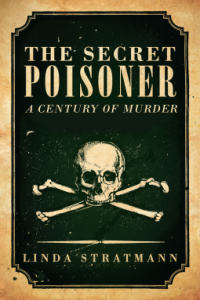
Non-Fiction
4*s
Well this is the book you want to read if you are interested, as I am, in poisoners through time and The Secret Poisoner concentrates mainly on those who made it to trial in the nineteenth century.
This isn’t just a book about the alleged poisoners and their possible victims though, it is about the birth of the expert witness, the different poisons available to both the typical poisoner; the wife, the servant or the offspring in hope of money but also those most feared of poisoners the medical men who did away with their patients under the guise of healing them and the judges who sentenced the perpetrators of this ‘cowardly crime’
There were various reasons for committing this particular crime and although the book doesn’t go into much detail as to the cause this book captures four cases that detail servants with a grudge against their employers, six poisoners who wanted to do away with inconvenient spouses or relatives and seven people who committed the crime for financial gain and these are just those who used the most common poison of the early nineteenth century, arsenic. The description of the death by this particular poison is gut-wrenching, although not as bad as for the poor victims!
The book also touches on the use of other poisons too, in particular laudanum which was the most common poison used on children, sometimes as an accidentally large dose to keep the little one quiet, but far more disquieting was those parents who used this drug to access the insurance taken out on their offspring’s lives.
This is a comprehensive book, with information about the scientists who devised tests for detecting poison in the body of the deceased, these tests were often demonstrated in court by the experts, many of whom it appeared were playing their own game of one-upmanship sometimes with disastrous consequences. Sadly the descriptions of the tests themselves had me no more interested than I was many moons ago in my chemistry lessons, but I understood enough to get the gist (I think!)
We also learn how frightened poisoning left the population at this time with stories in the press gleefully pouring out the details of the trials to their readers. In response to the public clamouring for action, the Pharmaceutical Society wrote a report to ensure that the sale of poisons became more regulated:
“In their united eagerness, their report may well have over-egged the poisoned pudding, making arsenic murder appear far more common than it actually was.”
Although this took a shockingly long time to make it into law finally
“On 17 February 1851, it was announced that parliament would introduce a measure to restrict the sale of arsenic.”
The author doesn’t ‘over-egg’ her own pudding though, pointing out that;
“After the passing of the 1851 Arsenic Act, no further legislation for the control of poisons was considered for some time. While available statistics show an increase in the number of poison murders bought to trial in the 1840s and 1850s, poison as a method of murder still remained rare compared to the various forms of physical violence.”
This book covers poisoners predominantly in the United Kingdom and France, although some Americans make an appearance towards the end of the book. Some of the crimes detailed were familiar, such as that of Glaswegian, Madeline Smith who I met in the Victorian Murderesses book by Mary S. Hartman who was accused of murdering her secret lover Pierre Emile L’Angeier who died from arsenic poisoning in 1857, of particular interest to me as the victim originally hailed from Jersey.
I don’t think there is a more comprehensive look at this particular type of crime and this book is quite dense, I certainly don’t recommend it as light reading, nor is it for those who easily feel queasy, believe me I’ve only lightly touched upon some of the unpleasant descriptions in-between these pages! The danger of course with the sheer volume of research packed into the book is that the crimes described can begin to merge into one, and as a result I did feel that it wasn’t always clear how this related to the laws being passed to prevent it, nor the increased chance of discovery due to the clever scientists. Despite that mild criticism which is easily overcome by not trying to pack this into a beginning to end reading experience, it was a simply fascinating read, particularly as the author rounds of her book with brief descriptions of some modern poisoners!
I’d like to say a big thank you to the publishers Yale University Press, London for allowing me to read a copy of this book, this review is my thank you to them. If you want to know anything at all about nineteenth century poisoners then The Secret Poisoner was published on 22 March 2016 so you can fill your boots with Linda Stratmann’s meticulous research.


